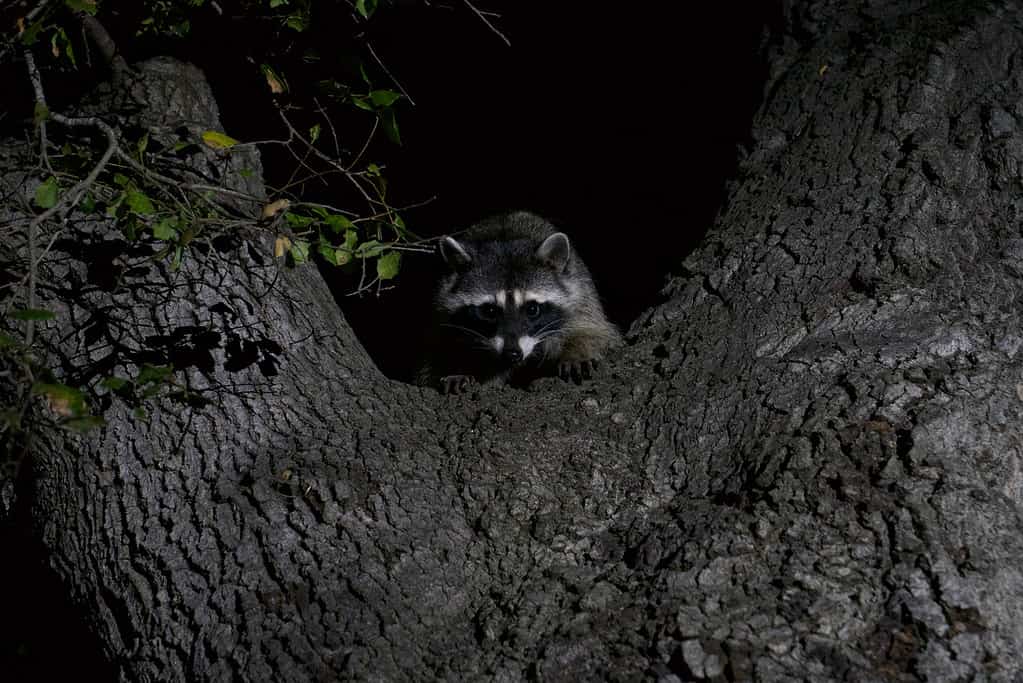Nocturnal animals are active during the night and sleep during the day.
Summary
Animals that sleep during the day (nocturnal) have developed enhanced senses of hearing and smell. They also have adapted special ways of seeing better in low light levels.
This is in contrast to diurnal animals, such as birds and squirrels, which are active during the day and sleep at night.
Some animals are crepuscular, which means they are mainly active in the twilight hours of dawn and dusk. They are more active during sunrise and sunset than either the day or night. Kangaroos are an example of a crepuscular animal as they mainly come out during the twilight period.
Pronunciation
Nocturnal is pronounced [naak·tur·nuhl]
Heightened Senses in Nocturnal Animals

Nocturnal animals such as raccoons have developed low-light sight and an increased sense of hearing and smell for navigating in the dark.
©iStock.com/Myrto Karamitsou
Nocturnal animals have highly developed senses for navigating in the dark.
Sight
Many nocturnal animals have eyes that can adapt to seeing well in low levels of light. For example, cats’ eyes can do both. They can see well in the dark, and their eyes can adjust to bright daylight. Animals such as owls and bush babies have large eyes, which help them to see in dim lighting levels.
Hearing and Smell
An increased sense of hearing and smell can help nocturnal animals navigate their way through the dark. Although raccoons’ eyes have adapted to see in the dark, they mainly rely on their strong sense of hearing and smell.
What Are the Advantages of Being Nocturnal?
There are several advantages for an animal to sleep during daylight hours and only venture out at night. These include:
- Less competition for resources. During the night, animals have less competition from other animals when looking for their next meal. When fewer animals are out and about, it means more resources for those that are.
- It’s easier to avoid predators. Not only are there fewer predators out during the night, but it’s also easier for animals to avoid detection in the dark.
- To hunt for prey. Many prey animals are active at night. Some predators that eat small mammals have adjusted their sleep schedules to match that of their prey.
- To avoid the midday heat. Many desert animals have evolved to be nocturnal to avoid the harshest time of the day when the sun is the highest.

During the night, animals have less competition from other animals when looking for their next meal.
©Amanda Guercio/Shutterstock.com
Nocturnal Origins: The Bottleneck Theory
Which came first? Diurnal animals or nocturnal? Scientists have a theory that nocturnal animals evolved to avoid being preyed upon by larger diurnal predators that hunted during the day. Millions of years ago, during the Mesozoic Era, many ancestors of modern mammals may have evolved to be nocturnal to avoid running into dinosaurs during the day. Scientists call this the bottleneck theory.
What is the Human Effect on Nocturnal Animals?
Human activity can disturb nocturnal animals. For instance, light pollution can confuse migrating animals that travel at night. Another animal affected by artificial light is the sea turtle.
Sea turtle eggs hatch at night, and the babies immediately head for the brightest light source. On a natural beach, this would be the bright water from the ocean as the night sky reflects on the waves. But artificial lights can lead hatchlings astray, and away from the sea.
Scientists also believe that humans may be driving some diurnal animals to become nocturnal to avoid human activity.

Artificial lights can lead sea turtle hatchlings astray, and away from the sea.
©Julian Wiskemann/Shutterstock.com
Which Animals Are Nocturnal?
Some examples of nocturnal animals are:
- Aardvarks sleep in their burrows during the day and come out at night to hunt ants and termites with their long noses and excellent sense of smell.
- Bats come out at night when their food source (insects) is the most active. They also can avoid predators at night.
- Fireflies, also known as lightning bugs, spend the day resting in tall grass. As dusk grows, they glow to attract mates.
- Leopards have exceptional eyesight and hearing, perfect for hunting at night.
- Moths. Many, but not all, moths are nocturnal. Moths fly at night and use light sources or the earth’s magnetic field to navigate.
- Opossums sleep all day in dens and come out at night to forage for food. Their eyes are constantly dilated to allow more light in, which works well for night vision, but is not an advantage during the day.
- Owls. Most owls hunt at night and sleep during the day. Their large eyes give them improved night vision while their sense of hearing helps them locate prey in the dark.
- Raccoons are active at night to avoid predators and forage for food. In addition to their night vision, they have a highly developed sense of touch, and they use their sensitive front paws to locate food in the dark.
- Rats are often found in cities and around humans. They come out at night to hunt for food to avoid detection by humans and other predators.
- Tasmanian devils spend their days sleeping in dens. They use the whiskers on their face and front legs to feel their way around in the dark.
- Wolves can avoid contact with humans and predators by only coming out at night. Their excellent night vision helps them to hunt their prey at night. However, they can be active during the day as well.



